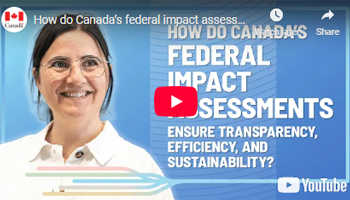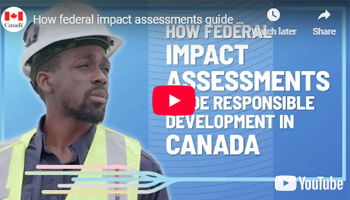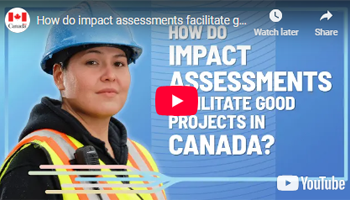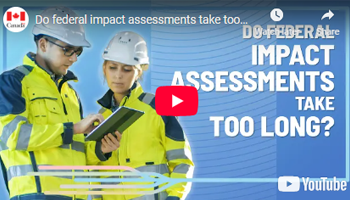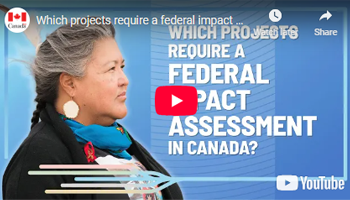How Canada does impact assessments differently | Video gallery
Discover how the Impact Assessment Agency of Canada (IAAC) is setting a new standard in how major projects are reviewed — with a focus on transparency, sustainability, Indigenous collaboration, and timeliness.
This video series features our President explaining how we do things differently. From reducing red tape to strengthening outcomes for the environment and Indigenous rights, these short, informative videos walk you through the key aspects of federal impact assessments.
How do Canada's federal impact assessments ensure transparency, efficiency, and sustainability?
Watch time: 1:48
Discover how Canada's impact assessment process protects the environment, Indigenous rights, and communities, while supporting sustainable development.
How do federal impact assessments balance economic growth and sustainability?
Watch time: 4:58
See how we balance environmental protection with economic growth while committing to delivering decisions in two years or less.
How federal impact assessments guide responsible development in Canada
Watch time: 1:05
Learn how our assessments shape better projects by addressing impacts on biodiversity, habitats, and nearby communities.
Why Canada conducts impact assessments?
Watch time: 1:00
Understand the core reasons we evaluate major projects like ports and mines before they move forward.
How do impact assessments facilitate good projects in Canada?
Watch time: 1:21
We zero in on what matters most — meaningful consultation and efficient assessments that lead to better project outcomes.
How does predictability drive successful impact assessments in Canada?
Watch time: 1:23
Discover how a clear and consistent assessment process benefits industries and builds public trust.
Do federal impact assessments take too long?
Watch time: 1:35
We're streamlining timelines without compromising integrity. Here's how we're doing it.
Which projects require a federal impact assessment in Canada?
Watch time: 1:35
Not all projects require federal review. Learn how we identify those that do.
How Canada's Impact Assessment Act supports investment and sustainability
Watch time: 1:16
Explore how regulatory clarity and sustainability make Canada a competitive destination for investment.
5 good things about federal impact assessments
Watch time: 2:59
We break down five key benefits of Canada's Impact Assessment Act — from climate action to better design.
How federal impact assessments guide responsible development in Canada
Transcript: How federal impact assessments guide responsible development in Canada
To be clear, let's acknowledge that federal impact assessments only pertain to major infrastructure and development projects, like hydroelectric dams, ports and large-scale mines.
I like to think of a federal impact assessment as a roadmap at the start of a project that will ultimately guide the design of the project so there is a better outcome for everyone involved.
In other words, our process helps understand and address the impacts of major projects on the surrounding people, places and biodiversity like plants and animals.
With assessments, we want to zero in on what matters to Canadians and Indigenous Peoples as quickly and efficiently as possible.
Things like impacts on Indigenous rights, water, species at risk, migratory birds and fish and fish habitat.
The process is all about making sure that natural resource and other kinds of major developments in Canada occur responsibly and sustainably, taking into account Canadian values, the environment and rights of Indigenous Peoples.
Why Canada conducts impact assessments?
Transcript: Why Canada conducts impact assessments?
Canada conducts federal impact assessments to minimize the impacts of big projects, like hydroelectric dams, ports and large-scale mines on the environment, local communities, Canadians and Indigenous peoples.
Make no mistake, Canada wants and needs development projects, especially ones that will advance our country's clean growth ambitions.
We want to be facilitators of good projects and to work with proponents, Indigenous peoples and Canadians to get there.
We see impact assessments as a road map that finds the right balance between the environment and the economy and helps us all get to a better outcome. Also, by conducting these assessments openly and transparently, we give Canadians a chance to have their voices heard in matters that affect them.
That ensures we don't miss anything that might be critical so there is a better understanding and acceptance of a project.
How do impact assessments facilitate good projects in Canada?
Transcript: How do impact assessments facilitate good projects in Canada?
Canada is an attractive place to invest for many reasons. An educated and growing population, stable government, solid banking system and a strong commitment to sustainable development.
For forward thinking companies, conducting an impact assessment before a project begins is just good business and it's what is socially and legally expected.
We know historically when meaningful consultation does not occur and issues that are important to communities and Canadians are not addressed, problems occur down the road. The impact assessment process is an early planning tool to help facilitate this work.
Canada wants and needs development projects, especially ones that will advance our country's clean growth ambitions.
So we're pulling out the stops to be facilitators of good projects and reexamining our own processes to zero-in more effectively on what matters most in terms of impact assessment.
When it comes to clean growth projects, we're also playing a role in coordinating any permits that might be necessary to help streamline the entire process for project proponents.
An impact assessment is simply a road map we create with a proponent at the front end of developing a project that puts the project and the community on the right path forward.
How does predictability drive successful impact assessments in Canada?
Transcript: How does predictability drive successful impact assessments in Canada?
We live in a complex country with different orders of government, legal and social support to protect indigenous rights, concerns for human health and protections for things like species at risk. But complexity is not the barrier.
After all, companies and other entities making multimillion-dollar investments with long term horizons are used to a degree of complexity already. What is more critical for industry is predictability.
We make our processes very clear and tailor our information needs to each project. We want to reduce the burden on proponents by zeroing in on what matters most. Our process is very clear and we ensure that all interested parties are informed about how to participate and what to expect.
For transparency, we post all documents, like letters and reports related to assessments on the Canadian Impact Assessment Registry website, so the public can review and comment on them. Each project page contains all the information people need about a project, including plans, reports and timelines. Permitting, for example, is the latest edition, so our system is not opaque.
Yes, it's complex, but my view it is meaningful and fully transparent.
Learn more
- Canada's impact assessment system
- Purpose and benefits of impact assessments
- Impact assessment process
Do federal impact assessments take too long?
Transcript: Do federal impact assessments take too long?
In the past, federal impact assessments have often taken longer than we would like.
There are many reasons assessments have advanced slowly. Sometimes project designs change, companies get sold, or project proponents haven't done their homework.
We are also looking at ways to do better on our end, too. We are committed to improving our review timelines without compromising our robust processes. With some tools in our toolbox, like cooperation agreements with provinces, we are confident we can achieve this.
We are committed more than ever is the idea of one project, one assessment, and we are working hard to achieve this. For example, the review of Cedar LNG, a liquefied natural gas project on Canada's West Coast, was completed in just over three years in cooperation with the province of British Columbia. That's a model to follow.
Our set timelines are also designed to keep the assessment process predictable and on track. By law, we can't pause an assessment once it's started, only the project proponent can. This means there are no unexpected stops and starts caused by us that could delay a final decision.
Finally, a strong majority of Canadians think it's important to get assessments right rather than to rush them and miss something. And that view is more or less consistent in every province. So we want to be more efficient at doing a good, reliable job people can count on.
Which projects require a federal impact assessment in Canada?
Transcript: Which projects require a federal impact assessment in Canada?
Let's be clear, only a small number of projects are even considered for a federal impact assessment.
We only focus on assessing major projects like transboundary pipelines, large-scale mines, marine shipping ports, nuclear facilities, etc.
These projects that experts believe have the greatest potential for adverse effects and federal jurisdiction.
And equally important, we consulted industry, experts, and others to determine the most critical projects to assess and published those in regulations known as the Project List. We are in the process of reexamining that list after five years, with the benefit of experience, science and Indigenous knowledge.
The minister can designate other projects to be considered for an impact assessment, but this is an exceptional power. Instances are rare and the conditions limited.
How Canada's Impact Assessment Act supports investment and sustainability?
Transcript: How Canada's Impact Assessment Act supports investment and sustainability?
The IAA benefits capital investment by increasing regulatory certainty and clarity.
Most advanced economies around the world have some form of impact or environmental assessment regime for major projects. All countries are concerned with sustainability and, at the same time, their ability to attract investment.
Overall, while Canada's process aligns closely with other advanced economies and its thoroughness, the specifics of implementation and emphasis can vary, reflecting each country's legal, cultural and environmental priorities.
What is most critical for industry is predictability. No one wants to operate on a football field where the sidelines and end lines change all the time.
We can and do address predictability by establishing clear expectations and time limits upfront with project proponents. That's why our aim is to tailor our information requests to the nature of each project and to focus on what matters most.
We are also committed to the principle of "one project, one assessment" to avoid duplication with other jurisdictions. That's why formal cooperation agreements with provinces are a top priority for us.
5 good things about federal impact assessments
Transcript: 5 good things about federal impact assessments
Canada’s amended Impact Assessment Act
#1 Impact assessments are transparent.
Participation leads to better outcomes
- We post all documents related to assessments on the Canadian Impact Assessment Registry.
- Each project page on the Registry contains all the information you need including plans, reports and timelines.
- There are different ways to participate at every step: join an information session, receive notifications, comment online or write to us.
- For certain groups, we provide funding to participate.
- Finally, when the Government makes a decision about a project, by law it has to give its reasons.
#2 Impact assessments have strict time limits.
New two-year target for assessments
- Set timelines are designed to keep the assessment process predictable – and on track.
- Each step has a set number of days for completion.
- Equally important, by law we can’t pause an assessment once it’s started – only the project proponent can.
- This means there are no unexpected stops and starts caused by us that could delay a final decision.
- Cooperation agreements with other jurisdictions can also avoid any unnecessary duplication.
#3 Impact assessments apply only to some specific projects.
Potential impacts drive need
- We consulted industry and others to determine the critical projects to assess.
- We landed on the ones with the greatest potential for adverse effects in areas of federal jurisdiction like dams, mines and marine terminals.
- We are also re-examining these types of projects with the benefit of experience.
- True, the Minister can designate other projects to be considered for an impact assessment, but instances are rare and the conditions are limited.
#4 Impact assessments provide predictability for industry.
Tailored requirements benefits investors
- Our process benefits investment by increasing regulatory certainty and clarity.
- It does this by establishing clear expectations and time limits up front with project proponents.
- Another way is by "tailoring" the requirements of each assessment to the nature and complexity of the project.
- Tailoring helps focus the assessment on the issues that matter to people the most.
- Our process also encourages collaboration among jurisdictions to reduce duplication and to support the principle of "one project, one assessment."
#5 Assessments will support Canada’s clean growth.
Efficiency by focusing on what matters
- The climate and biodiversity crises are at the forefront of Canada’s efforts to drive clean growth.
- An efficient and robust regulatory system is key to helping us get there – safely and responsibly.
- While most clean growth projects may not be subject to an assessment, those that are can count on a predictable, efficient and robust process that Canadians and Indigenous Peoples expect.
- We are also helping to coordinate permits for major clean growth projects.
Five good things
- Impact assessments are transparent.
- Impact assessments have strict time limits.
- Impact assessments only apply to certain projects.
- Impact assessments are predictable.
- Impact assessments support clean growth.
How do Canada's federal impact assessments ensure transparency, efficiency, and sustainability?
Transcript: How do Canada's federal impact assessments ensure transparency, efficiency, and sustainability?
Today, let's set the record straight about Canada's impact assessment process for major projects.
No secrets here: impact assessments are open and transparent. Public participation is key to their success with all studies and documents accessible online.
Got a project in mind? Federal assessments are limited to projects with the greatest potential for adverse effects in federal jurisdiction. Projects like large mines, dams and ports. And we review these types of projects periodically, by consulting with the public.
In business, time is money, so we always undertake assessments with this important fact in mind. You don't need to worry about the unexpected. The federal impact assessment process is clear and predictable; so, the process stays on track and on time.
We don't do it alone! The federal impact assessment process makes it easier for provincial, federal and Indigenous governments to assess projects together. Which is simply a better way for everyone!
There's a pretty good reason why assessments are important: well-planned projects not only safeguard people, the environment, and Indigenous rights, but also lead to more successful and sustainable outcomes for generations to come.
It just makes sense to complete an assessment before a project starts.
Canada's Federal impact assessment system. Timely. Efficient. For what matters. For more information on the Impact Assessment Act, visit: canada.ca/IAAC
How do federal impact assessments balance economic growth and sustainability?
Transcript: How do federal impact assessments balance economic growth and sustainability?
I’m Terry Hubbard, president of the Impact Assessment Agency of Canada. I’d like to set the record straight on how we deliver federal impact assessments.
All countries are concerned with sustainability and at the same time their ability to attract investment. Most advanced economies around the world have some form of impact or environmental assessment regime for major projects.
Here at the Agency, we work hand in hand with industry leaders, environmental experts, indigenous communities and the Canadian public to better understand and mitigate the impacts of major projects on people, places and our environment.
We’re talking about major projects like transboundary pipelines, large scale mines, marine shipping ports, nuclear facilities, et cetera. These are projects that experts say have the greatest potential for adverse effects in federal jurisdiction.
With assessments we want to zero in on what matters to Canadians and indigenous peoples as quickly and efficiently as possible.
The process is all about making sure that natural resource and other kinds of major developments in Canada occur responsibly and sustainably, taking into account Canadian values, the environment and rights of Indigenous peoples.
Canada wants and needs development projects. We see impact assessments as a road map that finds the right balance between the environment and the economy and helps us all get to a better outcome.
For forward thinking companies, conducting an impact assessment before a project begins is just good business and is what is socially and legally expected.
We know historically when meaningful consultation does not occur and the issues that are important to communities and Canadians are not addressed, problems occur down the road. By conducting these assessments openly and transparently, we give Canadians a chance to have their voices heard in matters that affect them.
For transparency, we post all documents like letters and reports related to assessments on the Canadian Impact Assessment Registry website so the public can review and comment on them.
The IAA benefits capital investment by increasing regulatory certainty and clarity. Our process is very clear and we ensure that all interested parties are informed about how to participate and what to expect.
Our set timelines are also designed to keep the assessment process predictable and on track. By law, we can’t pause an assessment once it’s started, only the project proponent can. This means there are no unexpected stops and starts caused by us that could delay a final decision.
In the past, federal impact assessments have often taken longer than we would like. It’s important to acknowledge that. So we’re pulling out the stops to be facilitators of good projects and reexamining our own processes to zero-in more effectively on what matters most in terms of impact assessment.
We are also looking at ways to do better on our end too.
We are committed to improving our review timelines without compromising our robust processes for example, by finding efficiencies, looking at scale and focusing on what matters. Our aim is to tailor our information requests to the nature of each project.
We are also committed to the principle of "one project, one assessment" to avoid duplication with other jurisdictions. That’s why formal cooperation agreements with provinces are a top priority for us.
We’re also playing a role in coordinating any permits that might be necessary to help streamline the entire process for project proponents.
A strong majority of Canadians think it’s important to get assessments right rather than to rush them and miss something.
As we move forward with more timely, efficient assessments, we remain committed to delivering what matters to Canadians: getting good projects built, protecting the environment, and ensuring the rights of Indigenous peoples are respected and upheld.
Canada’s impact assessment system benefits everyone.
